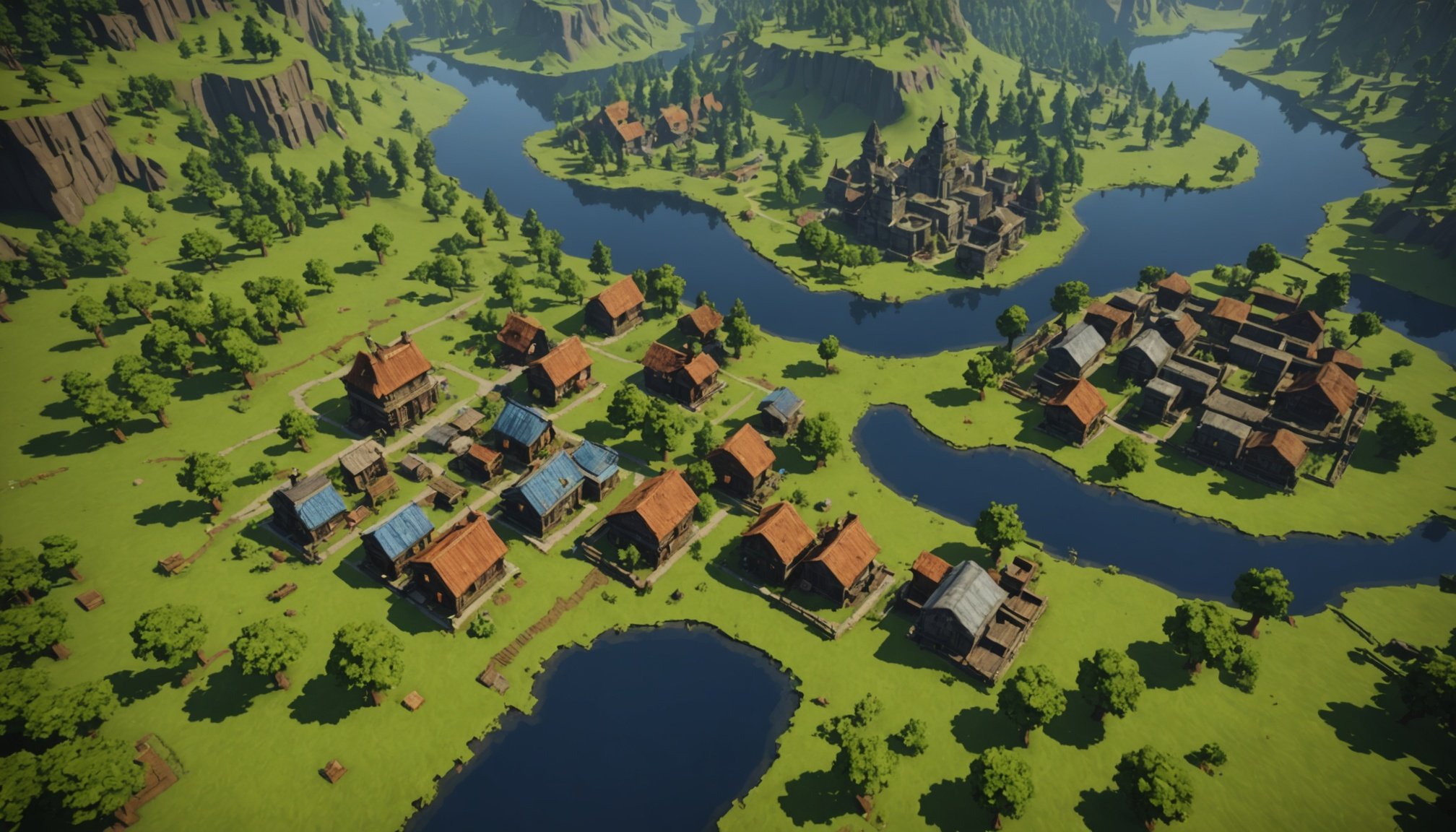Understanding Procedural Generation in Gaming
Procedural Generation, in the context of gaming, refers to the method by which content is algorithmically created rather than manually crafted. This technique significantly alters how game worlds evolve, allowing developers to create expansive and varied environments within their games. It fundamentally changes the composition of game worlds by using algorithms to generate complex structures, diverse terrains, and unique scenarios in real-time.
Historically, procedural generation has its roots in early game development, with its techniques becoming more complex over time. Initially used to overcome storage limitations, it has now evolved into a sophisticated tool in game design mechanics. Today, it’s prevalent in survival gaming, which often relies on its unpredictability to craft more engaging experiences.
Also read : Revolutionizing Game Narratives: The Impact of AI on Personalized Storytelling and Future Innovations
The importance of procedural generation lies in its ability to create limitless explorative possibilities. Players can traverse vast digital landscapes that are always fresh and engaging, encouraging deeper immersion. This technique is particularly appealing in survival gaming, where new game design mechanics can be continually introduced, keeping the gameplay novel and challenging. The ability to generate expansive and unpredictable worlds sets a fascinating, dynamic stage for players to explore.
Impact on Survival Gaming Experience
Survival gaming is particularly enriched by the use of procedural generation, creating a more immersive and dynamic player engagement. This method introduces an element of unpredictability, which is vital in survival gameplay as it demands players to continually adapt and strategise. The fluctuating environments and scenarios keep players invested and on edge, enhancing their overall survival gaming experience.
This might interest you : Transforming the New Player Experience: Cutting-Edge Expert Perspectives on AI-Powered Onboarding,slugslug
For instance, in procedural-generated survival games, exploration becomes a core mechanic, driving player engagement by offering limitless new surroundings to discover. No two sessions are identical, which encourages repeated play. This concept challenges players with unforeseen obstacles and novel paths, ensuring the gameplay remains fresh and engaging.
Games like Don’t Starve, Minecraft, and No Man’s Sky exemplify the effective use of procedural generation in introducing complexity and depth. By offering uniquely generated worlds each playthrough, these games have set high benchmarks for creativity and innovation in the survival gaming genre.
The interactive experience achieved through procedural generation significantly boosts the enjoyment and longevity of survival games. Its ability to foster deep player immersion and exploration fundamentally transforms how gamers interact with these digital worlds.
Benefits of Procedural Generation Techniques
Procedural generation offers substantial advantages in game design, particularly enhancing the replayability of games. Unlike traditional methods that can quickly become repetitive, procedural generation continuously creates unique gameplay experiences. This ensures that each playthrough provides something distinct, fostering sustained player interest. Replayability is crucial for games that thrive on engagement, as it encourages players to return, exploring new content.
In addition to replayability, procedural generation supports dynamic content creation, contributing to long-term player engagement. By generating diverse and unexpected scenarios, games remain fresh and appealing over time. This approach contrasts with the static nature of traditional content creation, which can become predictable.
Comparing traditional to procedural content creation in survival games, the difference is striking. While traditional content relies on pre-set designs, procedural generation allows for self-evolving game worlds, maintaining intrigue and novelty. This dynamism aligns with current expectations of immersive games, making procedural generation a preferred choice for developers aiming to keep their audience captivated. Ultimately, the adaptability and creativity inherent in procedural generation make it invaluable for sustaining player interest and engagement in modern gaming landscapes.
Notable Examples of Procedural Generation in Survival Games
Procedural generation has played a pivotal role in some of the most prominent survival games, creating worlds that are both expansive and unpredictable. Here, we delve into three classic examples where it shines:
No Man’s Sky
One of the most ambitious applications of procedural generation, No Man’s Sky utilizes complex algorithms to produce trillions of planets. Each offers distinct terrains and ecosystems, allowing endless exploration. Player feedback shows mixed reactions, noting awe in scale but occasional lack of depth, spotlighting procedural generation’s potential pitfalls alongside its benefits.
Minecraft
In Minecraft, procedural generation is a core mechanic, crafting endless terrains that encourage creativity and player engagement. Each new world challenges players afresh, inspiring unique building and survival strategies. Its simplicity combined with infinite complexity has set a high standard in procedural generation, making it a beloved staple in the gaming community.
Don’t Starve
Don’t Starve artfully blends procedural generation with survival game mechanics. The variability in its harsh environments ensures no two playthroughs are identical, keeping players continuously on their toes. This unpredictability, combined with its unique art style, has received praise for maintaining suspense and intrigue, crucial aspects in survival gaming.
Challenges and Limitations of Procedural Generation
Procedural generation is a transformative tool in gaming, but it comes with significant challenges. One of the main pitfalls is the potential for repetitiveness and a lack of meaningful content. While procedural generation can create vast worlds automatically, it may struggle to weave these spaces into a cohesive narrative or maintain a consistent artistic vision. This issue arises when algorithms fail to imbue generated content with emotional depth or engaging storylines, making some environments feel hollow despite their complexity.
Balancing technology with storytelling is another critical challenge. Developers must find the right equilibrium, ensuring that procedurally generated worlds still offer rich, immersive experiences. This often requires integrating handcrafted elements with procedural techniques to enhance depth and narrative richness.
Looking into the future, technological challenges remain. The integration of AI and machine learning in procedural generation promises innovative solutions, but implementing these technologies effectively is not without hurdles. Advanced AI might better understand user preferences, creating more tailored and meaningful experiences. However, successful integration demands significant resources and expertise, as the technology is continually evolving and often complex to manage.
Future Trends in Procedural Generation
The future of gaming is poised to be significantly shaped by advancements in procedural generation technologies. As developers strive for ever more complex game worlds, emerging technologies stand to revolutionize how these environments are crafted. One key area of innovation is the integration of AI and machine learning. These technologies promise to enhance procedural generation by enabling more personalised and responsive gameplay, tailoring challenges and environments to player preferences and behaviours.
The future of gaming will likely see procedural generation increasingly aligned with artificial intelligence, allowing for more adaptive and engaging gameplay experiences. AI can not only refine the generation process but also facilitate deeper narratives within procedurally generated environments, overcoming the current challenge of marrying technology with storytelling.
Another trend is the evolution of game development tools, which may become more accessible, allowing indie developers to harness procedural techniques without extensive resources. This democratization of tools and techniques could lead to a surge in creativity and diversity in game worlds.
As these technologies evolve, the gaming landscape may see unprecedented changes, with procedurally generated games offering not just new worlds but entirely new ways of engaging with digital experiences.





